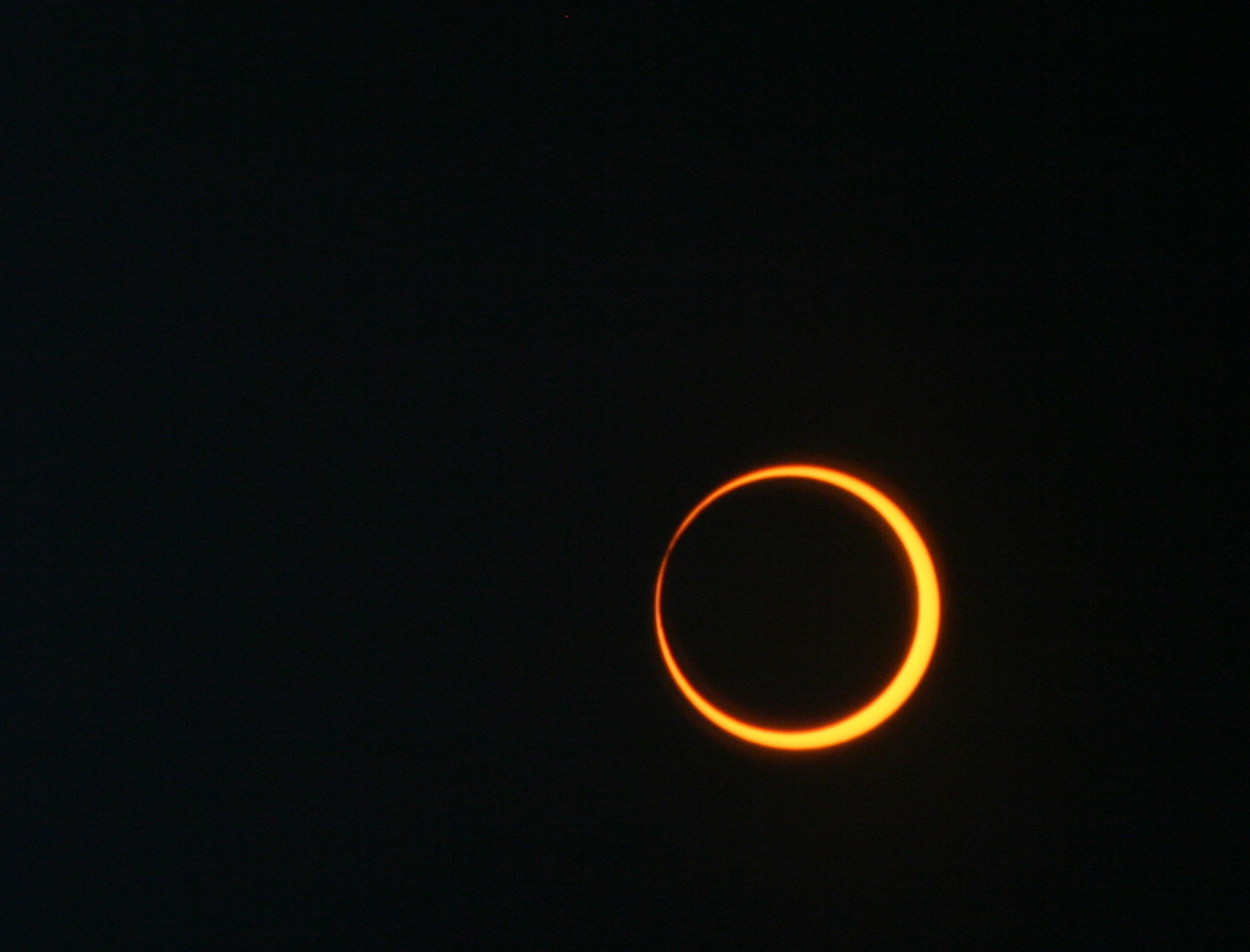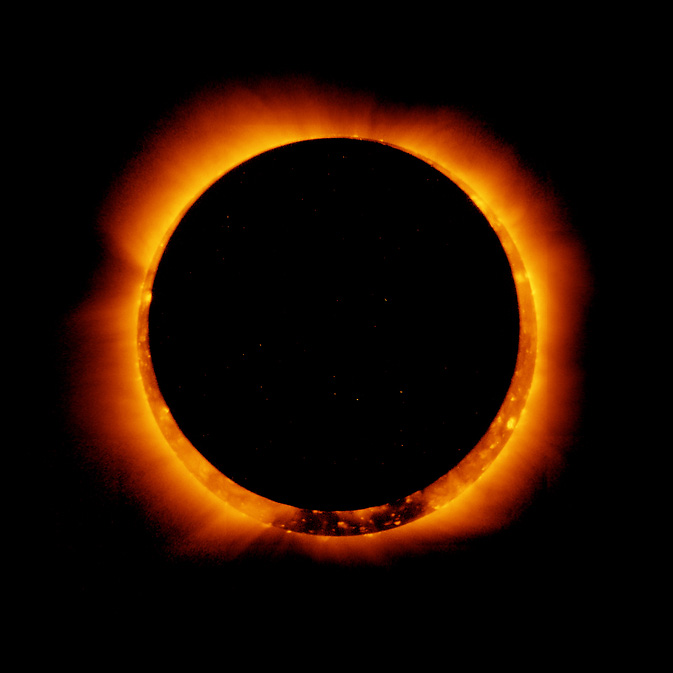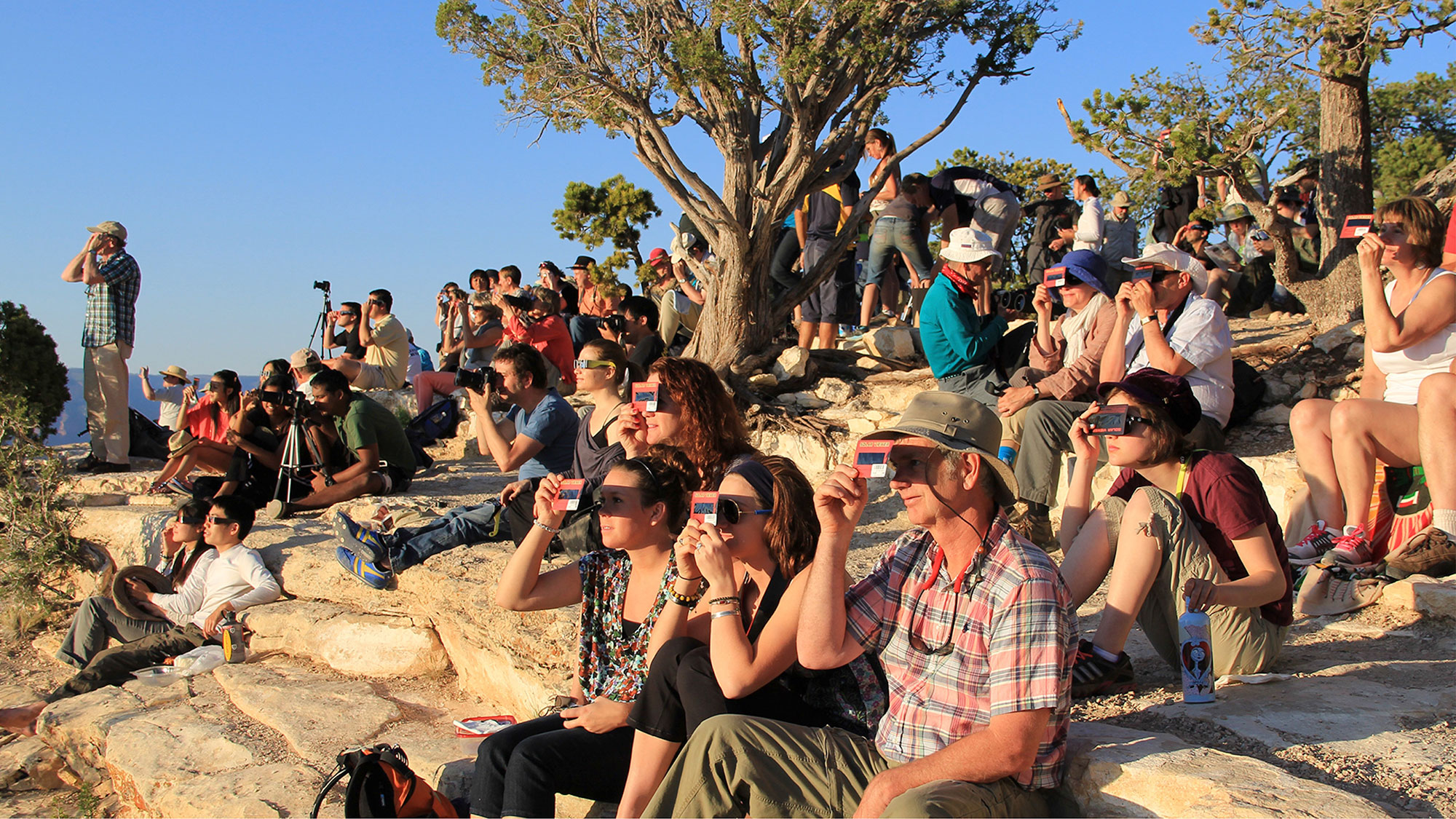General
What could you expect to see during the annular eclipse?
What you will see during the annular eclipse depends on where you are viewing the event. Those in the path of annularity will see a “ring of fire” in the sky, as the Moon passes in front of the Sun. Other viewers may see the Moon partially block the Sun. For more information about what to expect, visit this page.
What major cities are located on the path of annularity for the 2023 annular solar eclipse?
The annular solar eclipse will cross some major U.S. cities, including Eugene, Oregon, Alburquerque, New Mexico, and San Antonio, Texas. For more information, please visit the Where & When page.
What time of day will the annular eclipse be visible?
For viewers in the United States, the annular phase of the eclipse will start to be visible from around 9:15 a.m. to 11:50 a.m. in local time zones. The time the eclipse begins and ends changes based on the viewer's location. Depending on where the viewer is watching from, the annular phase of the eclipse could be as short as around 30 seconds to over 5 minutes.
For information about eclipse times, please visit our Where & When page.
Safety
How do you safely view an annular eclipse?
Looking directly at the Sun without protection is harmful to your eyes at any time during an annular eclipse. However, there are easy ways to see the annular eclipse.
The simplest safe way to view the eclipse is to watch the Sun's image projected onto a piece of paper. Poke a small hole in an index card with a pencil point, face it toward the Sun, and hold a second card three or four feet behind it in its shadow. You will see a projected image of the Sun on the second card.
You can learn more about safely viewing the 2023 annular eclipse from our safety page.
For information about solar filters and appropriate eyewear, please visit the American Astronomical Society website.
Can you view the annular eclipse with dark sunglasses or look at it without eye protection?
No. Regular sunglasses, no matter how dark, are not suitable for direct solar viewing. You must use specialized eclipse glasses or a filter rated for direct solar viewing to see this eclipse.
How are eyes damaged by staring at the Sun?
Typically, eye damage from staring at the Sun results in blurred vision, dark or yellow spots, pain in bright light, or loss of vision in the center of the eye (the fovea). Permanent damage to the retina has been shown to occur in ~100 seconds, but the exact time before damage occurs will vary with the intensity of the Sun on a particular day and with how much the viewer's pupil is dilated from decongestants and other drugs they may be taking.
Even when 99% of the Sun's surface (the photosphere) is obscured during the partial phases of a solar eclipse, the remaining crescent Sun is still intense enough to cause a retinal burn. Note, there are no pain receptors in the retina so your retina can be damaged even before you realize it, and by then it can be too late to save your vision!
Where can I get the right kind of solar filter to view the eclipse?
Another way is to use special "eclipse glasses" that are made from safe solar filter materials. You can also use solar filters that are designed to be used with a telescope.
To learn more about solar filters and eclipse glasses, please visit the American Astronomical Society website.
Is it only the bright light that is dangerous when viewing the Sun?
Although solar filters and eclipse glasses do safely block the intense sunlight that is known to damage retinas, the infrared ‘heat’ from the Sun can also make viewing uncomfortable as it literally warms the eye. This is why staring at the Sun for minutes at a time even with proper filters can still overheat the tissues and fluids in the eye. The consequences of this heating can be dangerous. To avoid this problem, frequently look away from the Sun to cool your eyes while using filters.
Resources
What eclipse resources are available for culturally responsive learning?
Eclipses hold significance across many cultures. There are multiple resources available for culturally responsive teaching. Here is a non-comprehensive list:
What resources are available for the Blind and low vision community?
Everyone can experience an eclipse. Here are some resources for the Blind and low vision community:
- Braille Books
- Eclipse Soundscapes in English & Espanol
What activities are available?
There are multiple activities available to learn more about eclipses and our Sun on our Activities page.
Science
What is the difference between an annular eclipse and a total solar eclipse?
A total solar eclipse happens when the Moon completely blocks the Sun. This occurs when the Moon passes between the Sun and Earth while it is close enough to Earth that it appears to be the same visual size as the Sun.
An annular solar eclipse happens when the Moon passes between the Sun and Earth while the Moon is at its farthest point from Earth. Because the Moon is farther away from Earth, it appears smaller and does not block the entire face of the Sun. As a result, the Moon appears like a dark disk on top of a larger, bright disk.
What are the stages of an annular eclipse?
An annular solar eclipse has five stages:
- 1st contact: This is the beginning of the partial phase of the eclipse. The Moon's silhouette begins to be visible in front of the Sun's disk, as if a bite was taken from the Sun.
- 2nd contact: This is the beginning of annularity. The Moon is fully in front of the Sun and a “ring of fire” (sunlight) begins to form around it. As annularity begins, beads of light called Baily's Beads may be seen along the edge of the Moon. These are caused by light rays from the Sun streaming through the valleys along the Moon's horizon
- Maximum eclipse: The Moon covers the center of the Sun's disk.
- 3rd contact: Annularity ends as the Moon starts to move away from the disk of the Sun. Baily's Beads may be visible once again along the Moon's edge.
- 4th contact: The partial eclipse ends. The Moon no longer overlaps the Sun's disk. The eclipse is over.
What causes an eclipse to occur?
Eclipses occur due to the special coincidence of the Moon and the Sun being the same angular size. The Sun is approximately 400 times wider than the Moon, but it is also approximately 400 times farther away, so they appear to be the same size in our sky. This is what allows the Moon to completely block the Sun during total solar eclipses.
However, the Moon's orbit around Earth is not a perfect circle, so when it is at its farthest point from the Earth the Moon will appear slightly smaller than the Sun. Eclipses that happen during this phase of the Moon's orbit are known as annular eclipses, and the Sun is still visible in a "ring of fire" encircling the Moon.
An activity that demonstrates this effect can be found here.
Why don’t eclipses occur every new moon?
The Moon’s orbit is "tilted" relative to the Sun-Earth line. As a result, sometimes the Moon's shadow is too high above Earth and sometimes it is too low. Other times, it is just right.
Are annular solar eclipses only visible from Earth?
Annular eclipses from Earth are a special type of astronomical transit. A transit is where one celestial body passes in front of another, more distant one but doesn’t entirely block out the farther object. The rovers on Mars have seen Phobos, the largest moon of Mars, transit the Sun much in the same way our own Moon will transit the Sun during an annular eclipse. But only an annular eclipse seen from Earth or a spacecraft in Earth’s orbit will have the small bright “ring of fire.” Scientists don't know of any other place in the Galaxy that has a "ring of fire" like an annular eclipse viewed from Earth.
What is a sunspot?
Occasionally, dark spots freckle the face of the Sun. These are sunspots, cooler regions on the Sun’s visible surface caused by a concentration of magnetic field lines. Sunspots are the visible component of active regions, areas of intense and complex magnetic fields on the Sun that are the source of solar eruptions.
Lasting from days to months, sunspots typically stretch 1,000 to 100,000 miles across. The number of sunspots goes up and down as the Sun goes through its natural 11-year cycle. Scientists use sunspots to help them track this cycle.
What is the Saros Series and Cycle?
Eclipses occur in patterns. The Saros Series is a period of 223 lunar months that has been used to predict eclipses for thousands of years. In a Saros Series, exactly 9 years, 5.5 days after any lunar eclipse, a solar eclipse will occur, and vice versa. Approximately 6585.3211 days, or 18 years, 11 days, and 8 hours after one eclipse, the Sun, Earth, and Moon return to about the same relative geometry, and a nearly identical eclipse occurs. These similar eclipses are part of the same Saros Cycle, and the time between the two eclipses is called a saros.
For eclipses that belong to the same Saros Cycle, the Moon will be at the same node and the same distance from Earth. Because one eclipse of a Saros Cycle occurs just 11 days later in the year than the last one, Earth will be at nearly the same distance from the Sun and tilted relative to it in nearly the same orientation (in the same season) as it was during the previous eclipse in that cycle. Each total solar eclipse path of totality looks similar to the previous one, but is shifted by 120 degrees westward.
Why do eclipse tracks move eastward even though Earth rotates from west to east?
Earth rotates eastward on its axis, which means the Moon, Sun, and stars appear to move from east to west across the sky. The Moon orbits Earth in the same direction as our planet rotates – eastward – but the Moon’s movement along its orbit is small compared to Earth’s daily rotation, making it difficult to notice the Moon’s eastward motion. However, during a solar eclipse, it is easier to observe this motion as the Moon crosses in front of the Sun from west to east. The Moon’s shadow follows in the same direction, tracing an eastward path across Earth’s surface.
How do modern-day scientists predict eclipses?
Astronomers first have to work out the geometry and mechanics of how Earth and the Moon orbit the Sun under the influences of the gravitational fields of these three bodies. From Newton's laws of motion, they mathematically work out the motions of these bodies in three-dimensional space, taking into account the fact that these bodies have finite size and are not perfect spheres. Scientists then feed the current positions and speeds of Earth and the Moon into these complex equations, and then program a computer to "integrate" these equations forward or backward in time to calculate the relative positions of the Moon and Sun as seen from the vantage point of Earth. Eclipses are specific configurations of these bodies that can be identified by the computer. Current eclipse forecasts are accurate to less than a minute in time over a span of hundreds of years.
How long will the annular solar eclipse on Oct. 14, 2023, last?
The length of the eclipse will depend on your viewing location. The partial phases will last 1 to 2 hours both before and after annularity. For most locations, annularity will last between 2 and 5 minutes, but it will be longer or shorter in some places.
What does the path of annularity mean?
The path of annularity is a path across Earth’s surface that indicates where you must be in order to see the “ring of fire” during an annular solar eclipse. Observers in some areas outside of this path of annularity will see a partial solar eclipse but won’t be able to see a complete ring.
How much will daylight change during an annular eclipse?
In the path of annularity, almost 90% of the Sun’s disk will be blocked by the Moon. The quality of the light will feel like the Sun is just rising or setting, and you will probably feel a change in the temperature, too. Off the path of annularity, the Sun will be blocked less than 90%, depending on where you are.
How are NASA missions participating in the annular eclipse? What science will they do?
Annular eclipses are good for testing out cameras that observe the Sun on the ground or in space. The dark shadow of the Moon is a sharp edge against the bright Sun, which can help with the calibration and alignment of telescopes.




